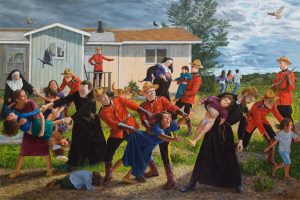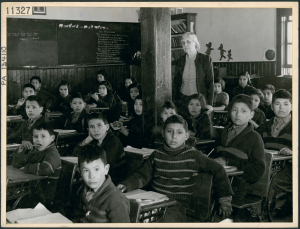6.5 The Genocide of Indigenous Peoples in Canada
From the actions of European settlers during colonization to Canadian Government policies, such as the Residential School (IRS) system and the Sixties Scoop, Indigenous peoples, as well as their cultures and ways of life, have been the target of systematic eradication (Fonseca, 2020; NCCIH, 2014). The experiences of Indigenous communities in Canada, especially experiences tied to the IRS and the Sixties Scoop, were referred to by the Truth and Reconciliation Commission (TRC) as cultural genocide (ATPN, 2015; Canada, n.d.; NCCIH, 2014; Staniforth, 2015). The findings of the National Inquiry into Missing and Murdered Indigenous Women and Girls (MMIWG) drew a different conclusion – that the Government of Canada perpetrated genocide against Indigenous peoples (MMIWG, 2019). As noted by Fannie Lafontaine (2021, para. 13), “Canada has demonstrated a continuing policy, with varying motivations but with an underlying intent that’s remained the same – to destroy Indigenous peoples physically, biologically and as social units“.

The criteria set forth in the UN Convention on Genocide (1948) can be applied to the IRS system to illustrate the appropriateness of the term genocide to describe Canadian government policies, actions and inactions. The IRS resulted in Indigenous children being forcefully removed from their communities to be assimilated into a Euro-Canadian style of life, at institutions run by the State and religious organizations (Colborn, 2021; Fonseca, 2020; Lafontaine, 2021; NCCIH, 2014). Children were often deliberately malnourished, housed in cramped and dirty quarters, and not provided medical treatment when they became ill (Daniel, 2021; NCCIH, 2014). Although the members of the Catholic Church are largely responsible for the mental, physical, sexual, and spiritual abuse that occurred within these schools (Colborn, 2021), “the Canadian government was happy to leave these children to die because they were Indigenous” (Staniforth, 2015, para. 10).

As of June 2021, there were “4117 [documented] deaths of First Nations, Inuit and Métis children at residential schools across Canada” (vanbuekl, 2021, para. 4). This number grows with each site study (Giles, 2022; House, 2022; Stewart, 2022). The refrain “Every Child Matters” has been used to show support for the continued exploration of all IRS locations. The genocide against Indigenous peoples in Canada, however, is much larger than the IRS or the Sixties Scoop. It continues in many ways today, for example, through inadequate government policies and action to address the crisis of murdered and missing Indigenous women and girls (MMIWG) (TVO Docs, 2019); and through insufficient government funding to address structural racism, evident in current living conditions in Indigenous communities throughout the country (i.e., water and air pollution, housing insecurity, inadequate educational and medical facilities, etc.), that continue to negatively impact the health and well–being and life-expectancy of Indigenous peoples (Richmond & Cook, 2016; NNCIH, 2014).
Click the links to learn more about the genocide committed against Indigenous peoples in Canada:
No Longer ‘The Disappeared’: Mourning the 215 Children Found in Graves at Kamloops….Residential School ![]() (Warning: Article contains use of some not up-to-date language illustrative of the language used when developing the RS school plan)
(Warning: Article contains use of some not up-to-date language illustrative of the language used when developing the RS school plan)
How Canada Committed Genocide Against Indigenous Peoples, Explained by the Lawyer Central to the Determination
VIDEO: Is It Really Genocide? In Canada?
In the following video, Indigenous activists, artists, and journalists Ian Campeau, Sarain Fox, Tanya Talaga, Jesse Wente, and Riley Yesno explain how the actions committed against Indigenous populations in Canada meet the international criteria for genocide.
"Structural racism refers to economic, social and political institutions and processes of a society that create and reinforce racial discrimination" (NCCIH, 2014).

